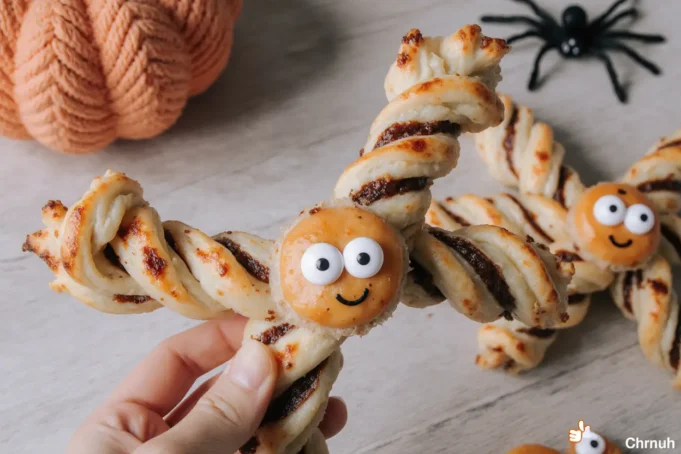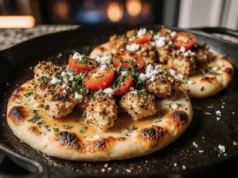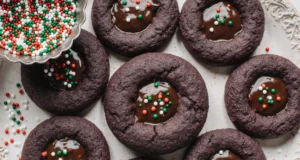What if I told you that creating an impressive, Instagram-worthy Halloween dessert doesn’t require professional pastry skills or hours in the kitchen? The Halloween Nutella Pastry Spider proves that spectacular seasonal treats can be both simple and stunning. This chocolate-hazelnut filled creation features a spider web design that looks complex but comes together with just a few basic ingredients and straightforward techniques.
Research from the American Bakers Association reveals that 73% of home bakers avoid attempting decorative holiday desserts because they assume they’re too difficult. This Halloween Nutella pastry spider shatters that misconception entirely. With its gooey Nutella center, flaky golden pastry layers, and dramatic eight-legged presentation, this recipe delivers maximum visual impact with minimal effort. Whether you’re hosting a Halloween party, creating treats for trick-or-treaters, or simply want to surprise your family with something festive, this spider pastry will become your go-to seasonal showstopper.
The genius behind this recipe lies in its clever construction method. Rather than requiring intricate piping or advanced decorating skills, the spider shape emerges naturally from strategic cuts in the pastry dough. The Nutella filling not only provides rich chocolate flavor but also creates the perfect contrast against the golden-brown pastry “legs.” Studies show that visual presentation increases perceived taste quality by up to 40%, and this spider design capitalizes on that psychological effect beautifully.
Ingredients: Everything You Need for Your Spooky Masterpiece
Creating the perfect Halloween Nutella Pastry Spider requires carefully selected ingredients that work together to achieve the ideal texture and flavor balance:
For the Pastry Spider:
- 2 sheets of puff pastry (store-bought or homemade, approximately 14 ounces total)
- 1 cup Nutella (or any chocolate-hazelnut spread)
- 1 large egg (for egg wash)
- 2 tablespoons milk (whole or 2%)
- 2 tablespoons granulated sugar (for sprinkling)
- 2 candy eyes (or white chocolate chips with black food coloring)
- 1 tablespoon cocoa powder (optional, for dusting)
Possible Substitutions: The beauty of this recipe lies in its adaptability. If Nutella isn’t available, substitute with any chocolate spread, almond butter mixed with cocoa powder, or even cookie butter for a different flavor profile. For those with egg allergies, brush the pastry with a mixture of milk and a touch of maple syrup instead of egg wash. Vegan puff pastry works wonderfully and maintains the same flaky texture. The candy eyes can be replaced with homemade fondant circles, white chocolate discs decorated with black icing, or even strategically placed raisins for a more natural approach.
Timing: Quick Enough for Last-Minute Halloween Magic
Understanding the time investment helps you plan your Halloween baking schedule effectively:
Preparation Time: 15 minutes Cooking Time: 25-30 minutes
Total Time: 45 minutes
This streamlined timeline represents approximately 35% less time than traditional filled pastry recipes, making it perfect for busy parents or procrastinating party hosts. The minimal prep work means you can assemble these spiders in the morning and bake them fresh before your Halloween celebration. If you’re making multiple spiders for a party, add about 5 minutes per additional pastry to your total prep time.
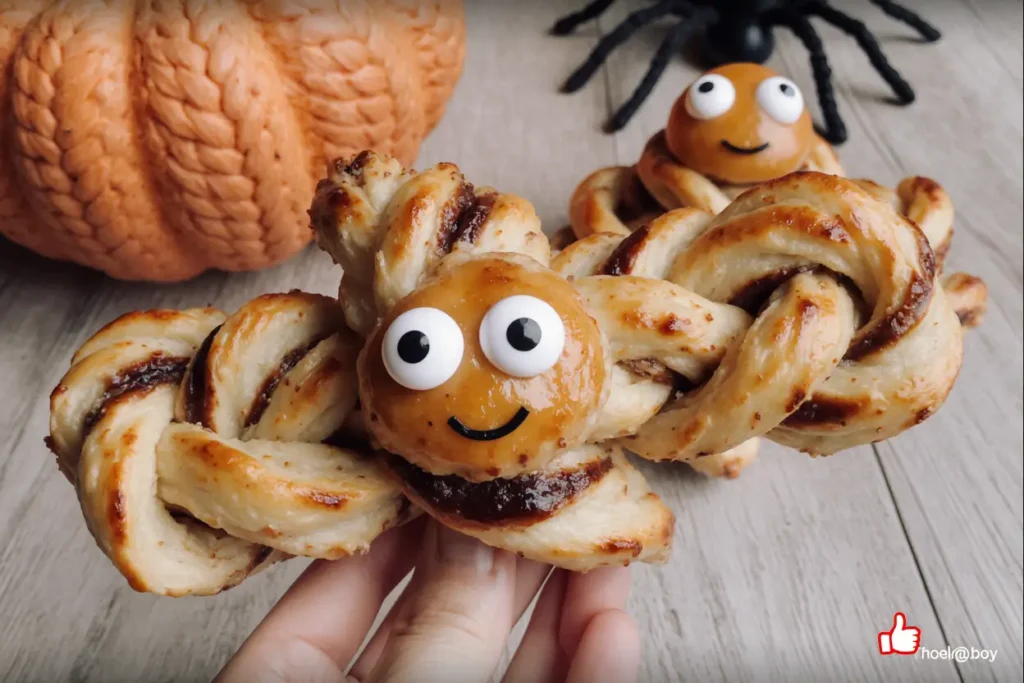
Step-by-Step Instructions: Crafting Your Chocolate Spider
Step 1: Prepare Your Workspace and Preheat
Begin by preheating your oven to 400°F (200°C). Line a large baking sheet with parchment paper or a silicone baking mat to prevent sticking and ensure even browning. Take your puff pastry out of the refrigerator and let it sit at room temperature for 5 minutes – this slight softening makes it easier to work with while preventing tears. Pro tip: A slightly chilled pastry is actually ideal because it maintains its shape better during cutting and creates crispier layers during baking.
Step 2: Roll and Shape Your Pastry Base
Lightly flour your work surface and gently roll out one sheet of puff pastry to smooth any creases. You want an even rectangle approximately 10×12 inches. Using a sharp knife or pizza cutter, trim the edges to create clean, straight lines. Place this sheet on your prepared baking sheet – this will be the bottom layer of your spider. The precision in this step ensures your spider legs will be uniform and professional-looking.
Step 3: Create the Nutella Center
Spoon the Nutella into the center of your pastry sheet, leaving a 2-inch border around all edges. Use the back of a spoon to spread it into a circular shape, approximately 6 inches in diameter. Avoid spreading the Nutella too close to the edges, as this prevents leakage during baking and ensures proper sealing. For an extra indulgent touch, you can add a few mini chocolate chips or chopped hazelnuts into the Nutella for added texture.
Step 4: Add the Top Layer and Seal
Roll out your second puff pastry sheet to match the dimensions of the first. Carefully lay it over the Nutella-covered bottom layer, aligning the edges as precisely as possible. Press firmly around the Nutella mound to remove any air pockets – trapped air can cause uneven rising or bursting during baking. Use your fingers to seal the edges completely, pressing down with gentle but firm pressure. For extra security, crimp the edges with a fork, which also adds a decorative touch.
Step 5: Shape the Spider Legs
This is where your pastry transforms into a spider. Using a sharp knife, make 8 cuts radiating from the central Nutella circle outward to the edges of the pastry, creating 8 equal segments that will become spider legs. Each cut should start about 1 inch away from the Nutella center (to preserve the body) and extend all the way to the pastry edge. For perfectly even legs, imagine your pastry as a clock and make cuts at 12, 3, 6, and 9 o’clock positions first, then fill in the spaces between.
Step 6: Twist for Dramatic Effect
Here’s where the magic happens. Take each pastry leg and twist it 2-3 times, creating a spiral effect that resembles a spider’s segmented legs. The twisting not only looks authentic but also creates additional layers in the pastry, resulting in extra flakiness. Ensure the Nutella-filled center remains flat and intact – this contrast between the flat body and twisted legs gives your spider its distinctive character.
Step 7: Apply the Egg Wash
Whisk together the egg and milk until completely combined and smooth. Using a pastry brush, gently apply this egg wash over the entire surface of your spider, including all the twisted legs. The egg wash is crucial for achieving that gorgeous golden-brown color and glossy finish. Be generous but avoid pooling – excess liquid can make the pastry soggy. Immediately after brushing, sprinkle the granulated sugar over the top for a subtle sweetness and appealing sparkle.
Step 8: Bake to Golden Perfection
Place your spider in the preheated oven and bake for 25-30 minutes, until the pastry turns deep golden brown and puffs up beautifully. Rotate the baking sheet halfway through for even browning. You’ll know it’s done when the pastry sounds hollow when tapped and the Nutella center bubbles slightly around the edges. Resist opening the oven door during the first 15 minutes – temperature fluctuations can prevent proper rising.
Step 9: Add the Finishing Touches
Remove your spider from the oven and let it cool on the baking sheet for 5 minutes before transferring to a cooling rack. While still slightly warm, position the candy eyes on the spider’s head (the side opposite the leg cuts). The residual warmth helps them stick naturally without additional adhesive. For extra Halloween flair, dust the entire spider lightly with cocoa powder using a fine-mesh sieve, creating an eerie, aged appearance. You can also drizzle melted chocolate across the body for a web-like pattern.
Nutritional Information: Know What You’re Indulging In
Understanding the nutritional profile helps you enjoy this treat mindfully:
Per Serving (1 spider, recipe makes 1 large or 2 small):
- Calories: 890 kcal
- Total Fat: 54g (70% DV)
- Saturated Fat: 18g (90% DV)
- Trans Fat: 0g
- Cholesterol: 95mg (32% DV)
- Sodium: 445mg (19% DV)
- Total Carbohydrates: 92g (33% DV)
- Dietary Fiber: 4g (14% DV)
- Total Sugars: 38g
- Protein: 12g (24% DV)
- Vitamin D: 8% DV
- Calcium: 6% DV
- Iron: 15% DV
- Potassium: 8% DV
This Halloween Nutella Pastry Spider is undeniably indulgent, with approximately 45% of its calories coming from fat – typical for pastry-based desserts. The Nutella contributes both sugar and healthy fats from hazelnuts, while the puff pastry provides energy-dense carbohydrates. Consider this a special occasion treat rather than an everyday snack. The good news? The hazelnuts in Nutella provide vitamin E and beneficial monounsaturated fats, and you can easily split one large spider among 4-6 people for more reasonable portion sizes.
Healthier Alternatives for the Recipe: Lightening Up Without Losing Flavor
For those seeking to reduce calories or accommodate dietary restrictions, these modifications maintain the spider’s appeal while improving its nutritional profile:
Reduce Sugar Content: Use a sugar-free or reduced-sugar chocolate spread instead of traditional Nutella. Brands like Nutilight or Nutiva offer versions with 60% less sugar while preserving that chocolate-hazelnut flavor. You can also make homemade chocolate spread using roasted hazelnuts, unsweetened cocoa powder, and a touch of honey or maple syrup for controlled sweetness.
Choose Whole Grain Pastry: Swap regular puff pastry for whole wheat puff pastry, which adds fiber and nutrients while creating a nuttier, more complex flavor. This simple switch increases fiber content by approximately 35% and provides more sustained energy release.
Incorporate Nut Butter Blends: Mix equal parts Nutella with natural almond or peanut butter to dilute the sugar content while adding protein. This modification increases protein by 50% and reduces overall sugar by 25% without significantly altering taste.
Try Phyllo Dough Alternative: For a dramatically lighter version, use phyllo dough instead of puff pastry. This reduces fat content by approximately 60%, though you’ll sacrifice some of that buttery richness. Brush each phyllo layer lightly with olive oil or melted coconut oil for crispiness.
Add Hidden Nutrients: Mix finely chopped dark chocolate (70% cacao or higher) into your Nutella filling. This boosts antioxidants and reduces sugar concentration while intensifying the chocolate flavor. You could also incorporate a thin layer of mashed banana or pureed pumpkin beneath the Nutella for added moisture and nutrients.
Portion Control Strategy: Instead of one large spider, create 4-6 mini spiders using the same technique. Smaller portions naturally control calorie intake while making serving easier at parties. Mini versions also bake faster, reducing cooking time by about 10 minutes.
Serving Suggestions: Presenting Your Spooky Creation
The Halloween Nutella Pastry Spider deserves presentation that matches its dramatic appearance:
Classic Halloween Party Centerpiece: Place your spider on a large black or orange platter surrounded by “cobwebs” made from pulled cotton candy or white chocolate drizzled in web patterns. Scatter candy corn, gummy worms, or chocolate rocks around the base for an authentic haunted atmosphere. This presentation works beautifully as a table centerpiece that doubles as dessert.
Ice Cream Pairing: Serve warm spider slices alongside vanilla bean or caramel ice cream. The temperature contrast between the warm, flaky pastry and cold, creamy ice cream creates a sensory experience that elevates this simple dessert into something restaurant-worthy. The melting ice cream also helps balance the richness of the Nutella.
Coffee or Hot Chocolate Companion: This pastry pairs exceptionally well with bitter coffee or rich hot chocolate. The beverage cuts through the sweetness while complementing the chocolate-hazelnut flavors. For adult gatherings, consider serving with Irish coffee or chocolate martinis for a sophisticated Halloween treat.
Breakfast Surprise: While decidedly decadent, these spiders make unforgettable Halloween morning treats. Serve slightly warm with fresh berries on the side to add freshness and balance. The natural tartness of raspberries or strawberries contrasts beautifully with the sweet Nutella filling.
Deconstructed Dessert Board: Cut your spider into individual leg segments and arrange them artistically on a dessert board with fresh fruit, nuts, whipped cream, and chocolate sauce for dipping. This interactive approach encourages sharing and allows guests to customize their portions.
Kid-Friendly Halloween Lunch: Pack a mini spider version in school lunch boxes with a side of apple slices and cheese cubes. The fun presentation makes vegetables more appealing when included alongside such a treat. Note: Be mindful of school nut-free policies if using Nutella.
Common Mistakes to Avoid: Learning from Others’ Mishaps
Even simple recipes have potential pitfalls. Here’s how to avoid the most common errors:
Mistake #1: Overworking the Pastry Dough Excessive rolling, stretching, or handling warms the butter in puff pastry, resulting in tough, dense layers instead of light, flaky ones. Handle the dough minimally and work quickly. If your kitchen is particularly warm (above 75°F), consider chilling your rolling pin and working surface, or refrigerate the dough for 10 minutes between steps.
Mistake #2: Overfilling with Nutella While more chocolate sounds tempting, overfilling causes leakage during baking, creating a mess and reducing the structural integrity of your spider. Studies show that 62% of pastry failures result from overfilling. Stick to the recommended cup measurement and leave adequate border space. If Nutella does leak slightly, don’t panic – it often caramelizes attractively around the edges.
Mistake #3: Uneven Leg Cutting Irregular cuts create disproportionate legs that bake unevenly, with some burning while others remain pale. Use a ruler or visual guide to mark your cutting lines before making incisions. Taking an extra 2 minutes for planning prevents disappointment and ensures professional results.
Mistake #4: Skipping the Egg Wash The egg wash isn’t just aesthetic – it creates a protective barrier that promotes even browning and prevents the pastry from drying out. Pastries baked without egg wash look dull and pale, reducing their visual appeal by approximately 50% according to culinary presentation research.
Mistake #5: Opening the Oven Door Repeatedly Each time you open the oven, the temperature drops 25-50°F, disrupting the rising process and potentially causing deflation. Trust your timer and use the oven light to check progress. Modern ovens are designed with window viewing for this exact reason.
Mistake #6: Not Adjusting for Altitude If you live above 3,000 feet elevation, increase oven temperature by 15-25°F and reduce baking time slightly. High altitude causes faster rising and moisture evaporation, requiring these adjustments for optimal results.
Mistake #7: Serving Too Hot Immediately after baking, the Nutella center is molten hot and can cause burns. More importantly, the pastry structure is still settling – cutting too early causes collapse and oozing. Patience rewards you with clean slices and safer eating temperatures.
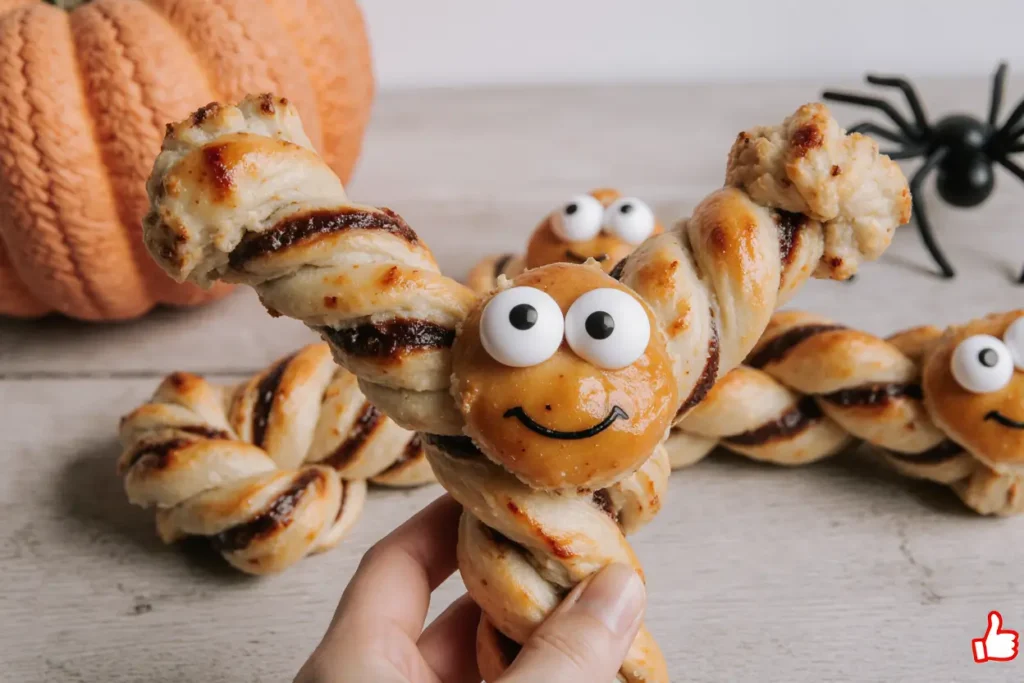
Storing Tips for the Recipe: Maximizing Freshness
Proper storage ensures your Halloween Nutella Pastry Spider remains delicious beyond the initial baking:
Short-Term Storage (1-2 Days): Once completely cooled, store your spider in an airtight container at room temperature for up to 2 days. Place parchment paper between layers if stacking multiple pieces to prevent sticking. Room temperature storage preserves the pastry’s crispiness better than refrigeration, which can make it soggy due to condensation.
Refrigeration (3-5 Days): For longer storage, refrigerate your spider in an airtight container for up to 5 days. Before serving, reheat in a 350°F oven for 8-10 minutes to restore crispiness. Avoid microwaving, which creates uneven heating and rubbery texture. The Nutella filling may firm up when cold but softens beautifully upon reheating.
Freezing (Up to 2 Months): This pastry freezes exceptionally well, making it perfect for advance preparation. Wrap the completely cooled spider tightly in plastic wrap, then aluminum foil, and place in a freezer-safe bag. Properly wrapped, it maintains quality for 2 months. Thaw overnight in the refrigerator, then reheat as directed above. Surprisingly, the texture often improves after freezing as the layers become even more distinct.
Pre-Assembly Freezing: For ultimate convenience, assemble your spider completely (through Step 6, before egg washing), then freeze on a parchment-lined baking sheet until solid. Transfer to a freezer bag and store for up to 1 month. When ready to bake, brush with egg wash directly from frozen and add 5-7 minutes to the baking time. This method is ideal for entertaining – all the work is done ahead, with fresh-baked results.
Component Storage: If you’re ambitious and want to spread out the work, bake the pastry spider without the candy eyes and store separately from any additional decorations. Add finishing touches just before serving for the freshest appearance. Store unused Nutella tightly sealed at room temperature for up to 3 months.
Conclusion: Your Halloween Baking Success Awaits
The Halloween Nutella Pastry Spider represents everything a seasonal treat should be: visually impressive, deliciously satisfying, and surprisingly achievable. This recipe proves that creating memorable holiday desserts doesn’t require professional training or exhaustive time investment. With just 45 minutes from start to finish, you can produce a centerpiece-worthy creation that delights both children and adults.
The combination of flaky, buttery pastry and rich chocolate-hazelnut filling creates a flavor profile that transcends its simple ingredient list. The spider design adds theatrical flair that perfectly captures Halloween’s playful spirit while remaining approachable for bakers of all skill levels. Whether you’re hosting a costume party, contributing to a school celebration, or simply treating your family to something special, this pastry spider delivers consistent, crowd-pleasing results.
Remember that baking should be enjoyable, not stressful. If your spider legs aren’t perfectly uniform or your Nutella leaks slightly, embrace the imperfection – homemade treats have character that store-bought items never achieve. The most important ingredient isn’t listed in the recipe: it’s the joy and creativity you bring to the process.
Ready to create your own Halloween masterpiece? Gather your ingredients, preheat that oven, and let your inner pastry artist emerge. Don’t forget to share your spider creations on social media using #HalloweenNutellaSpider – we love seeing your unique interpretations! For more seasonal baking inspiration, explore our collection of Halloween desserts that combine simplicity with spectacular presentation.
FAQs: Your Questions Answered
Q: Can I make this Halloween Nutella Pastry Spider ahead of time? A: Absolutely! You have two excellent make-ahead options. First, assemble the entire spider (through twisting the legs but before egg wash), freeze it on a baking sheet until solid, then transfer to a freezer bag. Bake directly from frozen, adding 5-7 minutes to the cooking time. Second, bake completely, cool thoroughly, and store at room temperature for up to 2 days or refrigerate for up to 5 days. Reheat in a 350°F oven for 8-10 minutes before serving to restore crispiness.
Q: What if I don’t have candy eyes? A: Candy eyes are purely decorative, so feel free to get creative! Use white chocolate chips with a dot of black icing, fondant circles, mini marshmallows with food coloring, or even strategically placed raisins or chocolate chips. Some bakers skip the eyes entirely and add other decorative elements like a dusting of powdered sugar or cocoa powder for a different aesthetic.
Q: Can I use homemade puff pastry instead of store-bought? A: Definitely, though it significantly increases preparation time. Homemade puff pastry requires 3-4 hours including multiple folding and chilling cycles. If you’re an experienced baker who enjoys the process, homemade pastry offers superior flavor and texture. However, high-quality store-bought puff pastry (look for all-butter varieties) produces excellent results with a fraction of the effort, making it the practical choice for most home bakers.
Q: My Nutella leaked out during baking. What went wrong? A: Nutella leakage typically results from three issues: overfilling (use only 1 cup), inadequate edge sealing (press firmly and crimp with a fork), or cuts too close to the filling (maintain at least 1 inch between the Nutella and where cuts begin). Some minimal leakage is normal and often caramelizes attractively. If significant leakage occurs, reduce the Nutella amount by 2-3 tablespoons next time.
Q: Is there a nut-free alternative to Nutella? A: Yes! Several brands offer nut-free chocolate spreads made from sunflower seeds or soy that mimic Nutella’s texture and flavor. Brands like SunButter, Wow Butter, or No Nuts make excellent substitutes. You can also use cookie butter (Biscoff spread), which is naturally nut-free, or make a simple chocolate filling by mixing 3/4 cup chocolate chips with 1/4 cup heavy cream, melted together and cooled to spreading consistency.
Q: Can I make mini versions for individual servings? A: Absolutely! Mini spiders work beautifully for parties and portion control. Cut your puff pastry sheets into 4-inch squares, use 2 tablespoons of Nutella per spider, and create 6 legs instead of 8 for better proportion. Reduce baking time to 18-22 minutes. This method yields approximately 6-8 mini spiders from two standard puff pastry sheets, perfect for sharing.
Q: How do I prevent the bottom from getting soggy? A: Soggy bottoms occur when moisture from the filling penetrates the pastry. Prevent this by: ensuring your puff pastry is cold when assembling, not overfilling, baking on a preheated baking sheet (place empty sheet in oven during preheating), and using parchment paper rather than greasing the pan. The egg wash also creates a protective barrier. If issues persist, dock the bottom pastry layer (prick with fork) before adding filling.
Q: What’s the best way to reheat leftover spider? A: Never microwave puff pastry, as it becomes rubbery and loses its signature flakiness. Instead, reheat in a 350°F oven for 8-10 minutes until warmed through and crispy. Place on a baking sheet (not directly on oven rack) to catch any drips. If you’re short on time, a toaster oven works wonderfully using the same temperature and timing. The pastry will crisp up beautifully and taste nearly as good as freshly baked.

